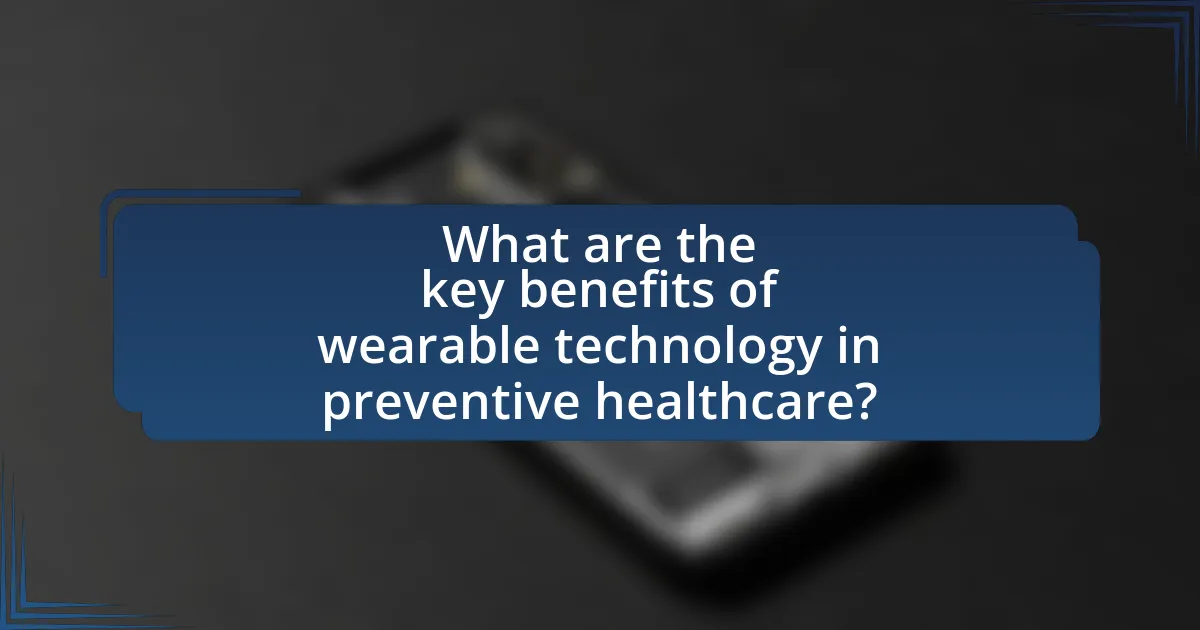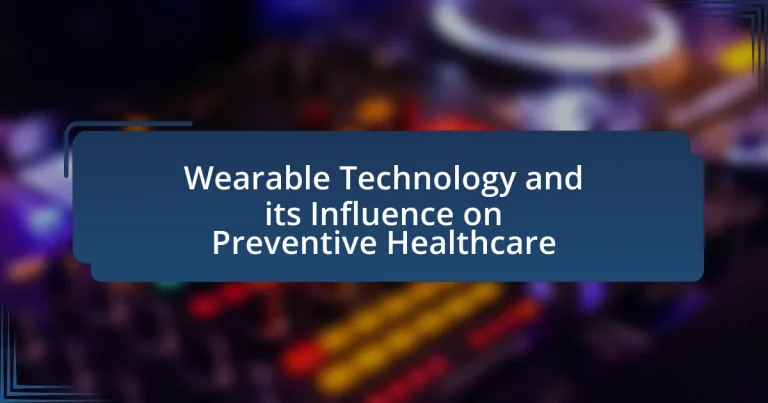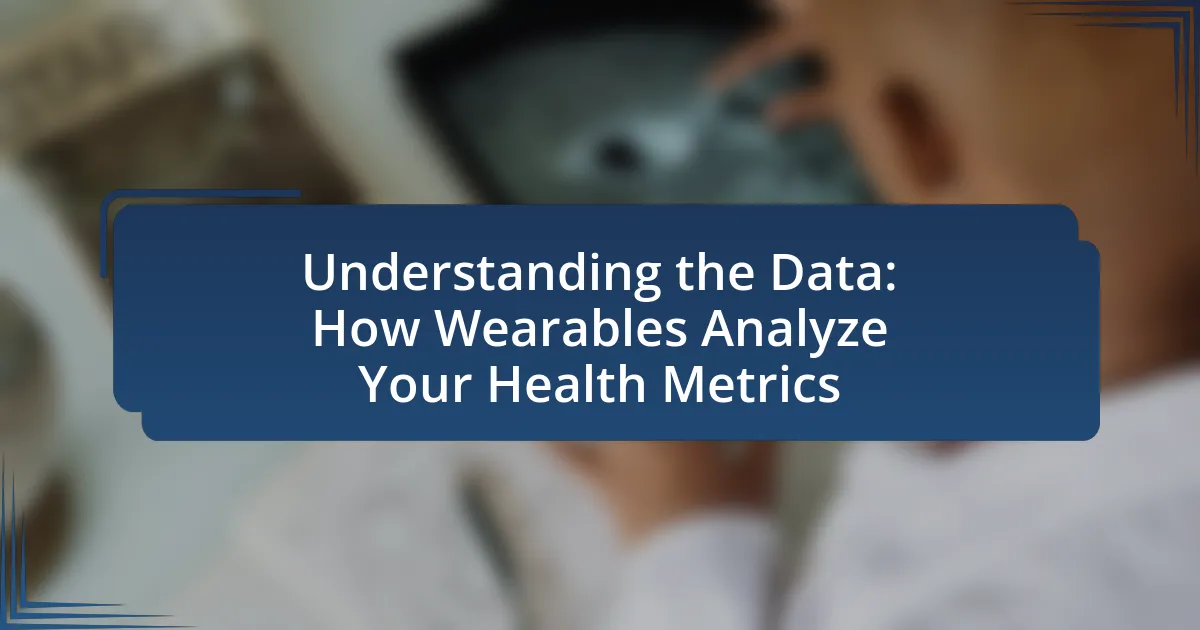Wearable technology in preventive healthcare encompasses electronic devices worn by individuals to monitor health metrics and promote wellness. This article explores the significance of wearable devices, such as fitness trackers and smartwatches, in facilitating continuous health monitoring, early detection of health issues, and enhancing patient engagement. It discusses the types of wearable devices commonly used, their role in chronic disease management, and the challenges they face, including data privacy and accuracy concerns. Additionally, the article highlights future trends in wearable technology, including advancements in sensor technology and the integration of artificial intelligence and telehealth, which are expected to further improve preventive healthcare outcomes.

What is Wearable Technology in Preventive Healthcare?
Wearable technology in preventive healthcare refers to electronic devices that individuals wear to monitor health metrics and promote wellness. These devices, such as fitness trackers and smartwatches, collect data on physical activity, heart rate, sleep patterns, and other vital signs, enabling users to track their health in real-time. Research indicates that the global wearable technology market is projected to reach $60 billion by 2023, highlighting its growing significance in health management. By providing continuous health monitoring, wearable technology empowers users to make informed lifestyle choices, potentially reducing the risk of chronic diseases.
How does wearable technology contribute to preventive healthcare?
Wearable technology contributes to preventive healthcare by enabling continuous health monitoring and data collection, which facilitates early detection of potential health issues. Devices such as fitness trackers and smartwatches can track vital signs, physical activity, and sleep patterns, providing users with real-time feedback on their health status. For instance, a study published in the Journal of Medical Internet Research found that wearable devices can significantly improve health outcomes by promoting physical activity and enabling timely interventions for conditions like hypertension and diabetes. This proactive approach to health management empowers individuals to make informed lifestyle choices, ultimately reducing the risk of chronic diseases.
What types of wearable devices are commonly used in healthcare?
Commonly used wearable devices in healthcare include fitness trackers, smartwatches, heart rate monitors, and continuous glucose monitors. Fitness trackers, such as those from Fitbit, monitor physical activity and sleep patterns, providing valuable data for health management. Smartwatches, like the Apple Watch, offer features such as heart rate monitoring and ECG capabilities, enabling users to track their cardiovascular health. Heart rate monitors, often used in clinical settings, provide real-time data on heart activity, which is crucial for patients with heart conditions. Continuous glucose monitors, such as those from Dexcom, allow diabetic patients to monitor their blood sugar levels continuously, improving diabetes management. These devices collectively enhance preventive healthcare by enabling real-time health monitoring and data collection.
How do these devices monitor health metrics?
Wearable devices monitor health metrics through sensors that track physiological data such as heart rate, steps taken, sleep patterns, and body temperature. These sensors utilize technologies like photoplethysmography for heart rate monitoring, accelerometers for movement detection, and gyroscopes for orientation and balance assessment. For instance, a study published in the Journal of Medical Internet Research indicates that wearable devices can accurately measure heart rate variability, which is a key indicator of cardiovascular health. By continuously collecting and analyzing this data, wearable technology provides users with real-time insights into their health, enabling proactive management of their well-being.
Why is preventive healthcare important in today’s society?
Preventive healthcare is important in today’s society because it reduces the incidence of chronic diseases and lowers healthcare costs. By focusing on prevention, individuals can identify health risks early, leading to timely interventions that improve health outcomes. For instance, the Centers for Disease Control and Prevention (CDC) reports that chronic diseases account for 70% of all deaths in the United States, highlighting the need for preventive measures. Additionally, investing in preventive healthcare can save an estimated $3.7 trillion in healthcare costs over the next 15 years, according to the National Academy of Medicine. This demonstrates that preventive healthcare not only enhances individual well-being but also contributes to the overall efficiency of the healthcare system.
What role does technology play in enhancing preventive healthcare?
Technology plays a crucial role in enhancing preventive healthcare by enabling real-time health monitoring and data analysis. Wearable devices, such as fitness trackers and smartwatches, collect vital health metrics like heart rate, activity levels, and sleep patterns, allowing individuals to gain insights into their health status. For instance, a study published in the Journal of Medical Internet Research found that wearable technology can lead to improved health outcomes by promoting physical activity and encouraging healthier lifestyle choices. Additionally, these devices can alert users to potential health issues, facilitating early intervention and reducing the risk of chronic diseases.
How can wearable technology reduce healthcare costs?
Wearable technology can reduce healthcare costs by enabling continuous health monitoring, which leads to early detection of medical issues and reduces the need for expensive treatments. For instance, devices like smartwatches and fitness trackers can monitor vital signs and physical activity, allowing users to identify potential health problems before they escalate. A study published in the Journal of Medical Internet Research found that remote patient monitoring can decrease hospital readmission rates by 25%, significantly lowering overall healthcare expenses. By promoting preventive care and encouraging healthier lifestyles, wearable technology ultimately contributes to cost savings in the healthcare system.

What are the key benefits of wearable technology in preventive healthcare?
Wearable technology in preventive healthcare offers key benefits such as continuous health monitoring, early detection of health issues, and enhanced patient engagement. Continuous health monitoring through devices like fitness trackers and smartwatches allows individuals to track vital signs, activity levels, and sleep patterns in real-time, leading to more informed health decisions. Early detection of health issues is facilitated by the ability of wearables to alert users to irregularities, such as abnormal heart rates, which can prompt timely medical intervention. Enhanced patient engagement is achieved as wearables encourage users to take an active role in their health management, often resulting in improved adherence to health recommendations. These benefits collectively contribute to better health outcomes and reduced healthcare costs.
How does wearable technology improve patient engagement?
Wearable technology improves patient engagement by providing real-time health data and personalized feedback, which encourages active participation in health management. Devices such as fitness trackers and smartwatches enable patients to monitor vital signs, activity levels, and medication adherence, fostering a sense of ownership over their health. Research indicates that patients using wearable devices are more likely to adhere to treatment plans and make healthier lifestyle choices, as evidenced by a study published in the Journal of Medical Internet Research, which found that 70% of participants reported increased motivation to engage in physical activity when using wearables. This direct interaction with health metrics enhances communication between patients and healthcare providers, leading to more tailored care and improved health outcomes.
What features of wearable devices encourage user interaction?
Wearable devices encourage user interaction through features such as notifications, health tracking, and customizable interfaces. Notifications provide real-time alerts for calls, messages, and reminders, prompting users to engage with their devices frequently. Health tracking features, including heart rate monitoring and step counting, motivate users to monitor their fitness levels and set personal goals, fostering a sense of accountability. Customizable interfaces allow users to personalize their experience, enhancing engagement by making the device more relevant to individual preferences. Research indicates that these interactive features significantly increase user satisfaction and adherence to health-related activities, as seen in studies published in the Journal of Medical Internet Research, which highlight the positive correlation between user engagement and health outcomes.
How does data sharing enhance patient-provider communication?
Data sharing enhances patient-provider communication by facilitating real-time access to health information, which allows providers to make informed decisions and engage patients in their care. When patients use wearable technology, such as fitness trackers or smartwatches, they generate continuous health data that can be shared with healthcare providers. This data includes metrics like heart rate, activity levels, and sleep patterns, enabling providers to monitor patient health more effectively. Studies have shown that when patients share their data, it leads to improved adherence to treatment plans and better health outcomes, as evidenced by a 2019 study published in the Journal of Medical Internet Research, which found that patients who actively shared data with their providers reported higher satisfaction and engagement in their healthcare.
What impact does wearable technology have on chronic disease management?
Wearable technology significantly enhances chronic disease management by enabling continuous monitoring of health metrics such as heart rate, blood glucose levels, and physical activity. This real-time data allows patients and healthcare providers to make informed decisions, adjust treatment plans, and improve adherence to prescribed therapies. For instance, a study published in the Journal of Medical Internet Research found that diabetes patients using wearable devices experienced a 20% improvement in glycemic control compared to those who did not use such technology. Additionally, wearables facilitate remote patient monitoring, reducing the need for frequent in-person visits and allowing for timely interventions, which can lead to better health outcomes and reduced healthcare costs.
How can wearables help in monitoring chronic conditions?
Wearables can help in monitoring chronic conditions by providing continuous, real-time data on vital signs and health metrics. These devices, such as smartwatches and fitness trackers, can track heart rate, blood pressure, glucose levels, and physical activity, enabling patients and healthcare providers to identify trends and make informed decisions. For instance, a study published in the Journal of Medical Internet Research found that wearables improved the management of diabetes by allowing for better glucose monitoring and timely interventions. This data-driven approach enhances patient engagement and adherence to treatment plans, ultimately leading to improved health outcomes.
What are the success stories of wearables in chronic disease management?
Wearables have significantly improved chronic disease management through successful implementations in diabetes monitoring and cardiovascular health. For instance, continuous glucose monitors (CGMs) like the Dexcom G6 have enabled patients with diabetes to track their blood sugar levels in real-time, leading to better glycemic control and a reported 1% reduction in HbA1c levels among users. Additionally, wearable devices such as the Apple Watch have integrated ECG functionality, allowing users to detect atrial fibrillation, which has been shown to reduce the risk of stroke when identified early. These examples illustrate how wearables enhance patient engagement and facilitate timely medical interventions, ultimately improving health outcomes in chronic disease management.

What challenges does wearable technology face in preventive healthcare?
Wearable technology faces several challenges in preventive healthcare, including data privacy concerns, accuracy of health metrics, and user engagement. Data privacy is a significant issue, as users are often hesitant to share sensitive health information due to fears of data breaches; a 2021 survey indicated that 60% of consumers are concerned about how their health data is used. Accuracy of health metrics is another challenge, as many devices may not provide reliable readings, which can lead to misdiagnosis or inappropriate health decisions; studies have shown that some wearables can have a margin of error of up to 30% in heart rate monitoring. Lastly, user engagement is critical, as many individuals may not consistently use these devices, with research indicating that up to 30% of users abandon their wearables within six months due to lack of motivation or perceived value.
What are the privacy concerns associated with wearable devices?
Wearable devices raise significant privacy concerns primarily due to the collection and transmission of personal health data. These devices often track sensitive information such as heart rate, location, and sleep patterns, which can be vulnerable to unauthorized access or data breaches. For instance, a 2021 report by the Identity Theft Resource Center indicated that data breaches in the health sector increased by 42% compared to the previous year, highlighting the risks associated with storing personal health information. Additionally, many wearable devices share data with third-party applications, which may not have stringent privacy protections, further exposing users to potential misuse of their data.
How is user data protected in wearable technology?
User data in wearable technology is protected through a combination of encryption, secure data storage, and user consent protocols. Encryption ensures that data transmitted between the device and servers is unreadable to unauthorized parties, while secure data storage practices prevent unauthorized access to stored information. Additionally, user consent protocols require explicit permission from users before collecting or sharing their data, aligning with regulations such as the General Data Protection Regulation (GDPR). These measures collectively enhance the security and privacy of user data in wearable devices.
What regulations govern the use of health data from wearables?
The regulations governing the use of health data from wearables primarily include the Health Insurance Portability and Accountability Act (HIPAA) in the United States, which mandates the protection of personal health information. Additionally, the General Data Protection Regulation (GDPR) in the European Union sets strict guidelines on data privacy and user consent for personal data, including health data collected from wearables. These regulations ensure that companies handling health data from wearables must implement security measures and obtain explicit consent from users before processing their data.
How can the accuracy of wearable technology be improved?
The accuracy of wearable technology can be improved by enhancing sensor precision and implementing advanced algorithms for data analysis. High-quality sensors, such as those using photoplethysmography for heart rate monitoring, can significantly reduce measurement errors. For instance, research published in the Journal of Medical Internet Research indicates that integrating machine learning algorithms can refine data interpretation, leading to more accurate health metrics. Additionally, regular calibration of devices and user feedback mechanisms can further ensure that wearables provide reliable data, as evidenced by studies showing that user engagement improves device performance.
What advancements are being made in sensor technology?
Advancements in sensor technology include the development of miniaturized sensors that enhance the accuracy and functionality of wearable devices. These sensors now incorporate advanced materials such as graphene and nanomaterials, which improve sensitivity and reduce power consumption. For instance, the integration of biosensors in wearables allows for real-time monitoring of vital signs like heart rate, blood pressure, and glucose levels, facilitating proactive health management. Research published in the journal “Nature” highlights that these innovations enable continuous health monitoring, which can lead to early detection of medical conditions, ultimately improving patient outcomes.
How do calibration and user compliance affect accuracy?
Calibration and user compliance significantly affect the accuracy of wearable technology in preventive healthcare. Calibration ensures that the device measures physiological parameters correctly, aligning its readings with established standards. For instance, a study published in the Journal of Medical Internet Research found that properly calibrated devices can reduce measurement errors by up to 30%. User compliance, on the other hand, refers to how consistently and correctly users follow the device’s instructions, which directly impacts data quality. Research indicates that higher compliance rates lead to more reliable data, with a 2019 study in the Journal of the American Medical Association showing that adherence to usage protocols improved accuracy by 25%. Together, effective calibration and high user compliance are essential for maximizing the accuracy of wearable health technologies.
What future trends can we expect in wearable technology for preventive healthcare?
Future trends in wearable technology for preventive healthcare include advanced biometric monitoring, integration with artificial intelligence, and enhanced data interoperability. Advanced biometric monitoring will enable devices to track a wider range of health metrics, such as glucose levels and hydration status, providing real-time insights into an individual’s health. Integration with artificial intelligence will facilitate personalized health recommendations based on collected data, improving preventive measures. Enhanced data interoperability will allow seamless sharing of health information across platforms, enabling healthcare providers to make informed decisions. According to a report by Grand View Research, the global wearable medical devices market is expected to reach $27.8 billion by 2026, highlighting the growing importance and adoption of these technologies in preventive healthcare.
How will artificial intelligence enhance wearable devices?
Artificial intelligence will enhance wearable devices by enabling real-time data analysis and personalized health insights. AI algorithms can process vast amounts of data collected from sensors in wearable devices, such as heart rate, activity levels, and sleep patterns, to provide users with actionable feedback. For instance, a study published in the journal “Nature” demonstrated that AI-driven wearables could predict health issues like atrial fibrillation with over 90% accuracy by analyzing heart rhythm data. This capability allows for early intervention and improved health outcomes, showcasing the significant impact of AI on preventive healthcare through wearables.
What role will integration with telehealth play in the future?
Integration with telehealth will play a crucial role in enhancing preventive healthcare by facilitating real-time monitoring and timely interventions. As wearable technology advances, it will enable continuous health data collection, allowing healthcare providers to analyze patient information remotely and make informed decisions. For instance, a study published in the Journal of Medical Internet Research found that telehealth interventions can significantly improve chronic disease management, demonstrating a 30% reduction in hospital readmissions among patients using remote monitoring tools. This integration will ultimately lead to more personalized care, improved patient outcomes, and reduced healthcare costs.
What best practices should users follow when utilizing wearable technology for health monitoring?
Users should ensure accurate health monitoring by regularly calibrating their wearable devices. Calibration helps maintain the precision of data collected, which is crucial for tracking health metrics effectively. Additionally, users should consistently wear the device as recommended, as studies indicate that continuous usage enhances data reliability and provides a comprehensive view of health trends over time. Furthermore, users must regularly update the device’s software to benefit from the latest features and security enhancements, which can improve functionality and data accuracy. Engaging with the device’s accompanying app can also provide personalized insights and recommendations, thereby optimizing health management.



